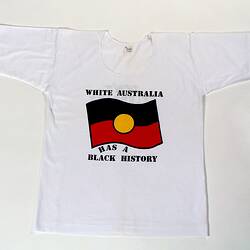Summary
Small black t-shirt sold by the toxic dump committee to raise funds for protests against the toxic waste depot being installed at Violet Town, Victoria, 2002.
Physical Description
Small Black 100% cotton t-shirt, label JB's, made in china, white logo on front "Who's killing Heidi Mr Bracks", pictures - sheep and cow with tree on (front), circle symbol "No toxic waste dump for Baddaginnie/Violet town" (back)
Significance
The t-shirts were used for fund raising and were an important tool to raise awareness within the community. The different slogans were used to engage the range of community interests. Some of the t-shirts were also distributed beyond the Violet Town community to Melbourne and other areas.
Youth were targeted with the "Who's Killing Heidi" shirt. Killing Heidi is a contemporary rock group, whose lead singer and guitarist (Ella and Jesse Hooper) grew up in Violet Town.
The "We Will Defend our Country": this t-shirt was not directed to nationalist sentiment, rather the protection of land. This shirt uses a cartoon by Michael Leunig, who lives locally in the Strathbogie tableland. Michael Leunig supported the campaign by designing this cartoon especially for the campaign and talked at the day of action when the Hume Freeway traffic was diverted at Violet Town to demonstrate the community opposition to a toxic waste site on the Folly Creek catchment (part of the Goulburn-Broken catchment). The cartoon was also used for the large freeway banners. The local community interpreted the image as a guardian angel, however Michael Leunig felt that it represented the power of the individual to effect change.
The "Farmland for Food" t-shirt was designed to communicate the issue of the location and impact of the toxic waste site on local food production. The proposed site was on the Goulburn-Broken catchment; historical records were used to demonstrate that flooding of this catchment would contaminate Victoria's food bowl.
Significance of the Toxic Waste Issue:
The campaign highlights the ongoing issues affecting our sustainable futures: waste management and landfill options, social and economic survival of small rural communities, protecting water catchment areas, zero waste policy, unsustainable consumption, and the inequity between city and country communities.
The campaign ironically became an excellent example of community capacity building by: bringing together small communities with a shared vision to challenge these proposals, providing a basis for the development of skills and knowledge, and creating a means of building cohesion within and between the communities.
The campaign affected three separate communities across Victoria, and was a means to build bridges of support across these different locations. Many groups that didn't traditionally mix or communicate came together in support of the campaign. All of the community was involved in the campaign. This level of participation created new understandings and opportunities to work more cooperatively as a community on an ongoing basis. For example, the Violet Town community has come together to fully support the rehabilitation of the Honeysuckle Creek: this support came directly as a result of the community spirit that was built through the Toxic Waste Campaign.
The Toxic Waste Campaign was represented by displays, banners, petitions, and other materials at the Horsham Women on Farms Gathering, March 2004.
Background:
Proposals for three toxic waste sites across Victoria were issued November 2003 to private landowners in the areas of Violet Town/Baddaginnie, Ouyen/Tiega, and Pittong/south of Ballarat. See for an initial media report of the proposal: http://www.abc.net.au/southwestvic/stories/s988264.htm. The local owners were contacted by a government representative and given a period in which to respond to the compulsory acquisition of their land for this purpose. Each community had approximately six months to prepare a response to the proposals.
The No Toxic Waste Dump committees were set up at each of the three locations to fight these proposals.
The previous campaign against a toxic waste site at Werribee was used as a guide for the Violet Town No Toxic Waste Dump committee. The Werribee Residents Against Toxic Dumps visited Violet Town to assist in developing the campaign: identifying the most effective methods for community and media, providing research to support the campaign, graphic designs for media releases, moral support and advice. The Werribee campaign began in April 1996 and won its campaign in November 1998 (See: http://www.21century.com.au/environment/wratd/Pressrel.htm)
The toxic waste campaigns in each of the three areas were successfully won. However, the current proposal is for a toxic waste facility on crown land at Hattah, north of Ouyen and south of Mildura (see: http://www.mildura.vic.gov.au/Page/page.asp?Page_Id=1391&h=0).
More Information
-
Collecting Areas
-
Acquisition Information
Donation from Ms. Kerry Wilson - Women on Farms Gathering Benalla, 13 Jul 2004
-
Person Named
Honourable Steve Bracks - State Government of Victoria, Violet Town, Victoria, Australia, 2002
-
Inscriptions
Text, front of shirt: 'WHO'S KILLING HEIDI/MR. BRACKS.'
-
Classification
Agriculture & rural life, Community activity, Protest materials
-
Category
-
Discipline
-
Type of item
-
Keywords
Agriculture, Gender Issues, Globalisation, Politics, Rural Life, Waste Management, Work

